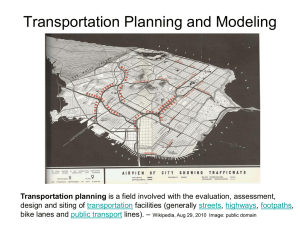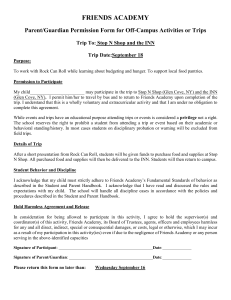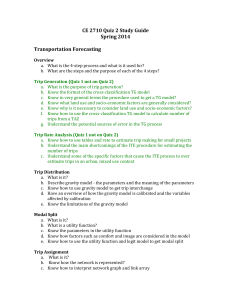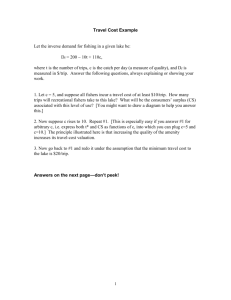Establish of EMME/2 model
advertisement
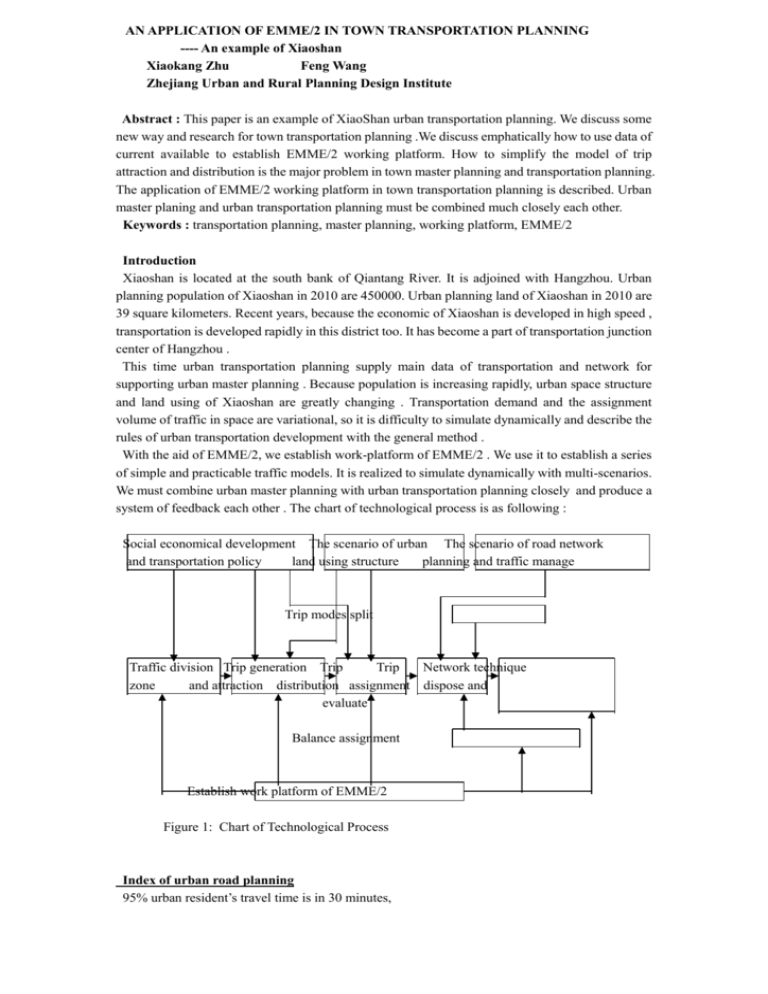
AN APPLICATION OF EMME/2 IN TOWN TRANSPORTATION PLANNING ---- An example of Xiaoshan Xiaokang Zhu Feng Wang Zhejiang Urban and Rural Planning Design Institute Abstract : This paper is an example of XiaoShan urban transportation planning. We discuss some new way and research for town transportation planning .We discuss emphatically how to use data of current available to establish EMME/2 working platform. How to simplify the model of trip attraction and distribution is the major problem in town master planning and transportation planning. The application of EMME/2 working platform in town transportation planning is described. Urban master planing and urban transportation planning must be combined much closely each other. Keywords : transportation planning, master planning, working platform, EMME/2 Introduction Xiaoshan is located at the south bank of Qiantang River. It is adjoined with Hangzhou. Urban planning population of Xiaoshan in 2010 are 450000. Urban planning land of Xiaoshan in 2010 are 39 square kilometers. Recent years, because the economic of Xiaoshan is developed in high speed , transportation is developed rapidly in this district too. It has become a part of transportation junction center of Hangzhou . This time urban transportation planning supply main data of transportation and network for supporting urban master planning . Because population is increasing rapidly, urban space structure and land using of Xiaoshan are greatly changing . Transportation demand and the assignment volume of traffic in space are variational, so it is difficulty to simulate dynamically and describe the rules of urban transportation development with the general method . With the aid of EMME/2, we establish work-platform of EMME/2 . We use it to establish a series of simple and practicable traffic models. It is realized to simulate dynamically with multi-scenarios. We must combine urban master planning with urban transportation planning closely and produce a system of feedback each other . The chart of technological process is as following : Social economical development The scenario of urban The scenario of road network and transportation policy land using structure planning and traffic manage Trip modes split Traffic division Trip generation Trip Trip Network technique zone and attraction distribution assignment dispose and evaluate Balance assignment Establish work platform of EMME/2 Figure 1: Chart of Technological Process Index of urban road planning 95% urban resident’s travel time is in 30 minutes, Road area ratio is 13%~15%, Density of road network is 1.2 kilometers per square kilometer, Average daily trips: 2.7 times per person, Passenger transportation structure: transit 15%,bicycle 45%,on foot30%,other 10%, Vehicle owner ratio: 95~105 vehicles per thousand persons. Scenario of urban land-using The form of Xiaoshan’s land use construct is four regions and one point. Including : residential land : 1082 hectares, industrial and : 807 hectares, warehouse land : 229 hectares, public facilities : arranged by city, regions, zones. Establish of EMME/2 model The establish of EMME/2 model of Xiaoshan means inputting the data of basic road network and some appropriate manipulates including network, matrix, function and parameter. On the basis of road planning scenario, we establish the fundamental road network which including node numbers, centroid numbers, links, link types(function, location and control), delay functions of links, junction penalty functions, demand matrix and so on. Description of EMME/2 demand model Trip generation and attraction forecasting Forecasting model: only forecasting the work-purposed trip and study-purposed trips which are based home. Model period: early peak hour. Trip population: work-purposed trip and study-purposed trips are mainly concerned in the trips in early peak hour in Xiaoshan. According to correlative urban transportation survey data, the ratio of the trip population to urban population is between 55% and 65%. The composition of floating population is very complex. We concern that the floating population is about 2% of urban population. Employment and education position distribute forecasting: Employment position distribution is equilibrium assigned according the labor composition and classification of urban land (eg. industry land, public facility, warehouse land). The basic data are presumed as followed: the position density of public facility is 250 persons per hectare. the position density of industry land is 200 persons per hectare. the position density of warehouse land is 50 persons per hectare. the position density of intercity transportation land is forecasted according to traffic source. Resident trips generation forecasting At present the index of average resident trip in town traffic planning is about 2.3~2.8 times per day. Based on the characteristic analyses of Xiaoshan urban resident, we assume the indexes as followed: In 2010 in Xiaoshan the average trips of urban resident are 2.7 times per people per day and the total trips of Xiaoshan are 1215000 times per day. The trips in early peak hour are 27 percent of full daily trips of Xiaoshan and the volume is 328000 times per day. The emphasis of this traffic generation forecasting are concerning of work trips and study trips based home in early peak hour. According to the survey data, 80 percent of urban labor have a work-purposed trip and all students have a study-purposed trip in early peak hour. The two kinds of trips in early peak period are 279000 times, occupying 85 percent of full trips in early peak period. Resident trips attraction forecasting Work-purposed attraction According to the population planning of Xiaoshan Master Planning, the labor positions of secondary industry are 149000 and the labor positions of tertiary occupation are 113000 in Xiaoshan in 2010. Combined with the land-used capacity index, the positions of employment of traffic zones are acquired by equilibrium assignment. Study-purposed attraction trips forecasting According to the location of schools of Xiaoshan, the numbers of students in traffic zones are acquired. Combined with urban population construct , the study-purposed attraction trips can be forecasted. Figure 2 shows the forecasting result of generation and attraction trips of Xiaoshan in 2120. Figure 2: Generation and Attraction Trips Trips distribution The scenario of land-using may vary much in Xiaoshan during planning period. So it may be invalid that the trip distribution model is calibrated based on current situation. The competition opportunity model is used to forecast trip distribution. Its description is that individual trip distribution depends on the distribution of opportunity probability of the destination and the resistance between origination and destination. X ij = (Uj /Vj ) * ( Ti / Σ( U j / Vj ) ) j where: Xij---trip distribution between zone i and zone j Ti----generation trip of zone i Uj----attraction trip of zone j Vj----total of attraction trip of the zones the resistance between which and zone j is lower or equal to the resistance between zone I and zone j. Traffic modes split While applying the competition opportunity model to forecast the trip distribution , we find that in Xiaoshan the choice of trip modes are under the influence of trip distance. With the improvement of level of transit service ,some pedestrians and bike-riders will turn to choose transit. According to the survey data in small town, the appropriate travel distance of pedestrian is 1~2 kilometers. The appropriate travel distance of bike-rider is 4~6 kilometers. The larger city is, the more people will choose transit. Recent years mobile vehicles of Xiaoshan are increasing in 26% annually. According to development of economic , the transportation policy of nation and the moderate development of private auto, we anticipated that there are 28000 mobile vehicles in Xiaoshan in 2010 , with 14000 auto among them . If private auto take on 15% urban trips of urban dwellers , the part of traffic volume will occupy more than 50% area of urban main road . Combined with the progress of economic growth of Xiaoshan, urban land use and characteristic of dweller trips , the system of urban passenger transportation should base on transit and bicycle mainly. The development of private auto must be controlled . Recommended urban transport construction is : transit 15%,bicycle 45,on foot30%,other 10%. Traffic assignment Traffic volume are assigned on road network with equilibrium model offered by emme/2. Equilibrium assignment model abides by principle that each user tries to minimize his travel time . If there is a path shorter than the one user is using , he will take it . when no user can improve his travel time , model that tries to describe the behavior of individuals by minimizing the individual costs . The delay functions of road are described by three parameters of traffic flows , and are modified by practical condition of road. Figure 3 shows the forecasting auto volumes in early peak hour in 2010. Figure 3: Auto Volume in Early Peak Hour Conclusion Previously, we have discussed the course how to using emme/2 in transportation planning in the stages of city master planning . It is must be emphasized that emme/2 brings convenience in transportation planning for us . When doing transportation planning in urban master planning ,we may use tools of constructing model and matrix computation in emme/2 conveniently. Meanwhile we may obtain data required in transportation planning. Reference 1. User’s Manual of EMME/2,(1997),INRO Consultants Inc. 2.Urban Master Planning of Xiaoshan,(1997), Zhejiang Urban and Rural Planning Design Institute.


